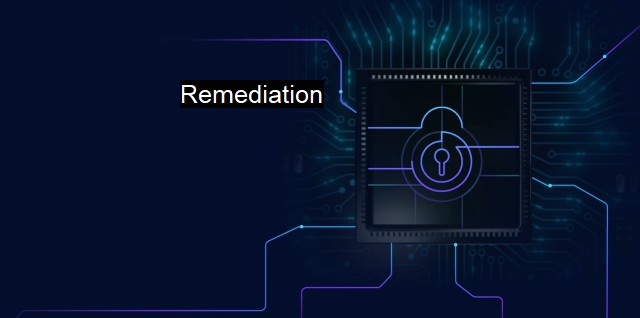What is Remediation?
Exploring the World of Remediation in Cybersecurity and Antivirus: Definitions, Types, and Applications
In the cybersecurity and antivirus context, remediation refers to the process of dealing with or resolving a security breach, threat, or vulnerability that can potentially harm a computer system, network, or an application. It is a recursive activity performed in response to any cybersecurity-related problem. Organizations employ remediation programs to identify security vulnerabilities, build action plans, prioritize and assign tasks, enforce remediation activities, and produce management level reports.The term cybersecurity implies applying solutions to keep various devices and data protected from digital attacks, typically aimed to gain unauthorized access to, destroy, or exploit delicate information. Whereas the antivirus denotes software designed to detect, prevent, and take action to disarm malicious programs or 'viruses' intruding upon a computer system. Coupled together, cybersecurity and antivirus, they create the first line of defense against sophisticated cyberattacks.
Remediation works in tandem with these privacy and security tools, focusing on resolving security anomalies. The main objective of remediation is to ultimately reduce and maintain the necessary security postures of a network environment below an acceptable risk level while rehabilitating affected systems to their normal working conditions. Simply put, to undo or mitigate the damages caused by successful or unsuccessful hacking attempts.
In polymerized cybersecurity structures, vulnerabilities are destined to surface irrespective of numerous deployed security control measures. Herein, remediation activities broadly include patch and vulnerability management, phishing simulation and awareness training, incident response, and recovery measures.
Patching is a crucial process of applying updates ('patches') to software applications to reform security holes, fix or enhance functionalities, leading to establishing smoother and safer operations. Vulnerability management involves identifying, classifying, prioritizing, treating, and mitigating security vulnerabilities. Through routine scans and tests, latent and potential vulnerabilities are evaluated against specific metrics to convey their risk levels.
Phishing, a common form of cyber-crime, involves fraudulent attempts to obtain sensitive data under deceptive pretenses. Counteractive measures like phishing simulations give a real-world perspective about the nature of threats and foster a safer online culture and cyber hygiene within the organization by understanding and recognizing the modus operandi in such attacks.
Incident response urges to immediately respond to a security breach, to control the situation, minimize damages, and reduce recovery time and costs alike. Standard procedures, notified users, outlined responsibilities, checklists are amongst the many remediation measures post-incident occurrence.
Recovery activities denote the final yet essential step of the remediation process, focusing on returning to normal operations, assessing the recovery process, and learning from the incidence.
Effective remediation strategy demands automation through specialized security tools. Real-time reporting is an add-on preference for streamlining remediation procedures through insolating affected zones, identifying vulnerabilities in software and applications, and leaving as little as exposure time for hackers to exploit.
Consider this, while the individual focus of cybersecurity extends to prevention through detection, defense, and deterrence against cyber-attacks, the antivirus amplifier's these efforts by combating viral threats, also undertaking protecting network integrity as its hallmark.
Remediation serves the all-important job of taking the torch forward by healing often grave effects of a hard-determined and propagated cybersecurity breach. Effective remediation not only aids in damage control, restoring to nominal operations and reinforcing security strategy but immensely benefits from instilling a sense of assurance to mitigate similar threats in the future.
Thus, in the broader cyber-battle, remediation places itself as the washing up good habit to cybersecurity's diligent cooking amidst the antivirus's vigilant purchasing, ensuring a secure, sound, functioning, and trouble-free cyber household.

Remediation FAQs
What is remediation in the context of cybersecurity and antivirus?
Remediation in cybersecurity and antivirus refers to the process of identifying, containing, and eliminating threats, vulnerabilities, or attacks on a computer system.What are the common types of remediation in cybersecurity and antivirus?
There are several types of remediation in cybersecurity and antivirus, including patch management, malware removal, system configuration changes, network segmentation, and endpoint isolation.Why is remediation important in cybersecurity and antivirus?
Remediation is critical in cybersecurity and antivirus because it helps protect computer systems from attacks and reduce the risk of data breaches. Without remediation, malicious actors can exploit vulnerabilities and steal sensitive information, resulting in financial losses and reputational damage.What are the best practices for remediation in cybersecurity and antivirus?
Effective remediation in cybersecurity and antivirus requires a proactive and continuous approach that includes regular software updates, security assessments, threat intelligence, incident response planning, and employee training. It's also essential to have a detailed and well-documented remediation process that outlines roles, responsibilities, and escalation procedures.Related Topics
Malware removal Vulnerability assessment Penetration testing Digital forensics Network segmentation
| | A | | | B | | | C | | | D | | | E | | | F | | | G | | | H | | | I | | | J | | | K | | | L | | | M | |
| | N | | | O | | | P | | | Q | | | R | | | S | | | T | | | U | | | V | | | W | | | X | | | Y | | | Z | |
| | 1 | | | 2 | | | 3 | | | 4 | | | 7 | | | 8 | | |||||||